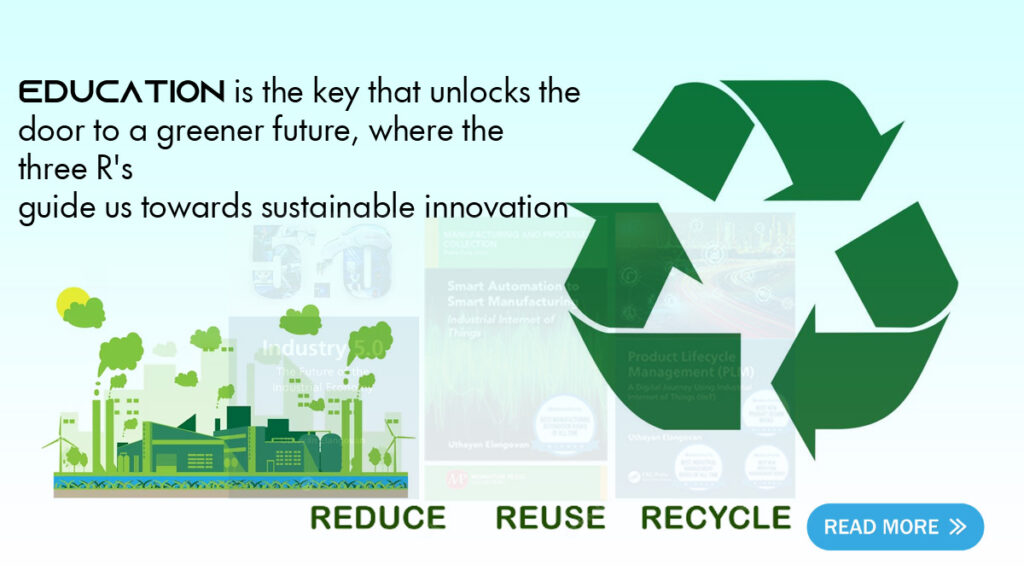Driving Sustainable New Product Development: Lessons for Manufacturers from 3R (Reduce, Reuse, Recycle)

Today, while engaging in a conversation with my son, who is a bright sixth-grader and an active member of his school’s Green Club, I found myself inspired to delve deeper into the topic of the 3R: Reduce, Reuse, Recycle. As he excitedly shared his newfound knowledge about these principles, it became apparent to me that the lessons taught in schools regarding sustainability and environmental responsibility hold immense value for not only young minds but also for manufacturers worldwide. It is a testament to the curiosity and enthusiasm of young learners like my son, who inspire us to reflect on our actions and embrace more sustainable practices for a better future.
Introduction:
The principles of 3R – Reduce, Reuse, Recycle have become fundamental in addressing the pressing challenges of environmental sustainability. As the world grapples with the impact of rapid industrialization and consumption patterns, manufacturers have a pivotal role to play in promoting sustainable new product development. I have taken an attempt to explore how the principles of 3R can guide manufacturers in sustainable new product development, showcasing examples and technological innovations that help put these principles into practice.
- Reduce: Minimizing Environmental Footprint
The first principle, Reduce, urges manufacturers to minimize their environmental footprint by optimizing resource consumption throughout the product life cycle. This approach involves the efficient use of raw materials, energy, and water, as well as the reduction of waste generation.
a) Design for Sustainability: Manufacturers are adopting design strategies that prioritize sustainability from the outset. For instance, companies are exploring lightweight materials to reduce energy consumption during transportation. Adidas, a leading sportswear manufacturer, introduced the Futurecraft Loop shoes, made entirely from recyclable materials. These shoes can be returned to Adidas at the end of their life cycle to be recycled into new shoes.
b) Resource Efficiency: Advanced manufacturing technologies, such as additive manufacturing (3D printing), allow manufacturers to optimize material usage and minimize waste. By printing products layer by layer, 3D printing reduces material waste and enables customization. For instance, Volvo Trucks employed 3D printing to manufacture complex components, resulting in a 90% reduction in prototype lead times and substantial material savings.
- Reuse: Extending Product Lifespan
The principle of Reuse emphasizes the importance of extending a product’s lifespan to reduce the demand for new products. Manufacturers can achieve this through refurbishment, remanufacturing, and implementing circular business models.
a) Remanufacturing: Companies like Caterpillar and Xerox have successfully integrated remanufacturing into their business models. Caterpillar remanufactures components and equipment, giving them a second life. This reduces waste, saves resources, and provides cost-effective solutions to customers.
b) Circular Economy: Manufacturers are embracing circular economy principles by designing products with modularity and upgradability in mind. For example, Fairphone, a sustainable smartphone manufacturer, offers modular phones that can be easily repaired and upgraded, reducing electronic waste. This approach aligns with the “take-back” programs, where customers return used products to manufacturers for proper disposal or refurbishment.
- Recycle: Closing the Materials Loop
Recycling is a key pillar of sustainable new product development, promoting the recovery of valuable materials and reducing the need for extracting new resources. Manufacturers can contribute to recycling efforts through product design, waste management, and collaborating with recycling initiatives.
a) Material Selection: Manufacturers are opting for recyclable and biodegradable materials to facilitate easier recycling processes. For instance, Dell introduced closed-loop recycling, where discarded plastic from e-waste is processed into new laptop casings. This approach reduces environmental impact and conserves resources.
b) Collaborative Initiatives: Partnerships between manufacturers, government bodies, and recycling organizations are instrumental in establishing efficient recycling systems. For instance, the Ellen MacArthur Foundation’s New Plastics Economy initiative aims to create a circular economy for plastics, bringing together manufacturers, governments, and NGOs to rethink the way plastic is designed, used, and recycled.
Check out other articles on Green Manufacturing here.
Technological Innovations Driving Sustainable New Product Development:
Several technological innovations support sustainable new product development, enabling manufacturers to implement the principles of Reduce, Reuse, Recycle effectively.
Internet of Things (IoT) and Sensors:
IoT-enabled sensors help track and optimize resource consumption, monitor product performance, and enable predictive maintenance. This data-driven approach empowers manufacturers to identify areas for improvement, reduce waste, and enhance product longevity.
Artificial Intelligence (AI) and Machine Learning:
AI-powered algorithms analyze vast datasets, enabling manufacturers to identify patterns and optimize production processes. AI can also be used to optimize energy usage, improve supply chain efficiency, and forecast product demand, reducing waste and environmental impact.
Renewable Energy Integration:
Manufacturers are increasingly transitioning to renewable energy sources to power their operations. Solar panels, wind turbines, and energy storage systems help reduce greenhouse gas emissions and dependence on fossil fuels, aligning with the sustainability agenda.
Product Lifecycle Management (PLM):
PLM supports the implementation of circular economy practices. It allows manufacturers to track and manage product returns, refurbishment, remanufacturing, and recycling processes. By integrating these functionalities into PLM systems, manufacturers can efficiently capture data on product end-of-life and enable closed-loop material flows, reducing waste and maximizing resource utilization.
Conclusion:
The principles of 3R – Reduce, Reuse, Recycle provide valuable guidance to manufacturers worldwide in their pursuit of sustainable new product development. By embracing these principles and leveraging technological innovations, manufacturers can create innovative products that minimize environmental impact, extend product lifespans, and contribute to the circular economy. The examples and advancements highlighted in this article demonstrate the potential for transformative change in manufacturing practices, paving the way for a more sustainable and prosperous future.
Check out some resources on Green PLM!
Learn about Industry 5.0!


